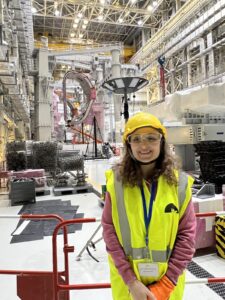Zinkle Fellow and Assistant Professor Livia Casali has been selected as one of only five representatives from the United States to participate in the International Thermonuclear Experimental Reactor (ITER) research plan.
Casali traveled to Aix-en-Provence and the ITER site in southern France from February 13-15 to meet with ITER Organization members and experts from six other domestic agencies. Together, they reviewed and discussed high-level strategy, machine configuration of the new ITER baseline research plan, and outlined experimental objectives, detailed goals of each phase, as well as high-level risks and mitigation strategies.
Casali Shares Expertise
 ITER, the world’s largest fusion experiment, is under construction and is expected to be completed by 2025. The project is being funded by an international collaboration of 35 nations that includes the US, China, Japan, India, Russia, South Korea, and the European Union.
ITER, the world’s largest fusion experiment, is under construction and is expected to be completed by 2025. The project is being funded by an international collaboration of 35 nations that includes the US, China, Japan, India, Russia, South Korea, and the European Union.
Each ITER member nominated five experts in late 2023 for representation, with a preference for younger contributors who will have a greater opportunity to be involved in ITER’s scientific exploitation.
“It is hard to describe the excitement of being there, feeling a part of something really big,” Casali said. “I’m happy that my expertise can move us one step closer to the achievement of one of the most important developments in human history.”
During the first ITER research plan development workshop, Casali and the other representatives heard about the details of the ITER baseline and research plans before splitting into five working groups. The groups performed detailed evaluations, concluding with a final session during which all the groups reported their findings.
Future Plan for ITER
The ITER Organization will submit a new project baseline to the ITER Council for consideration in June of 2024. The new baseline includes modifications to the configuration of the ITER device and its ancillaries as well as additional testing of components and phased installation to minimize operational risks.
“It was a pleasure and honor to be at the ITER site and be part of such an important step for ITER future directions, such as helping with the ITER research plan with such an amazing team of experts from all over the world,” Casali said. “It was also impressive to visit the ITER construction site and see with my own eyes all the progress that is happening with all the new buildings and various components. It was like another place compared to my last visit a few years ago.”
Contact
Rhiannon Potkey (865-974-0683, rpotkey@utk.edu)